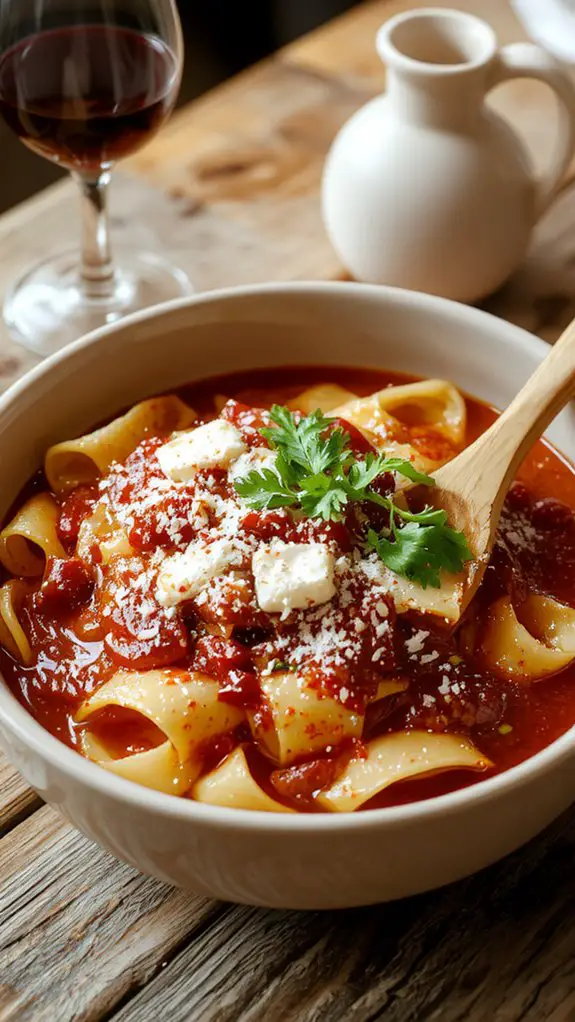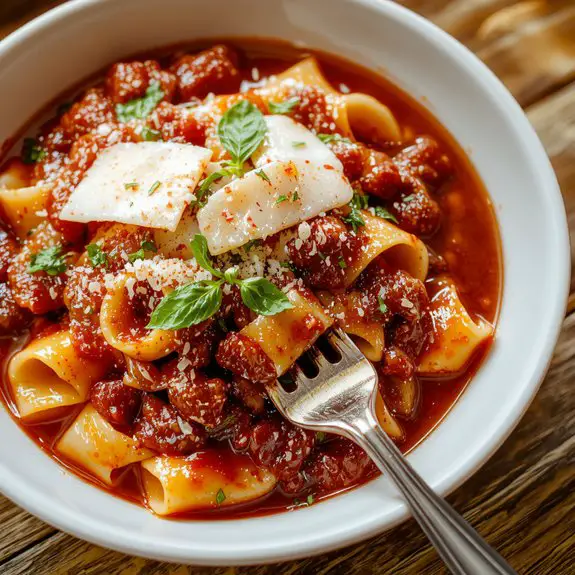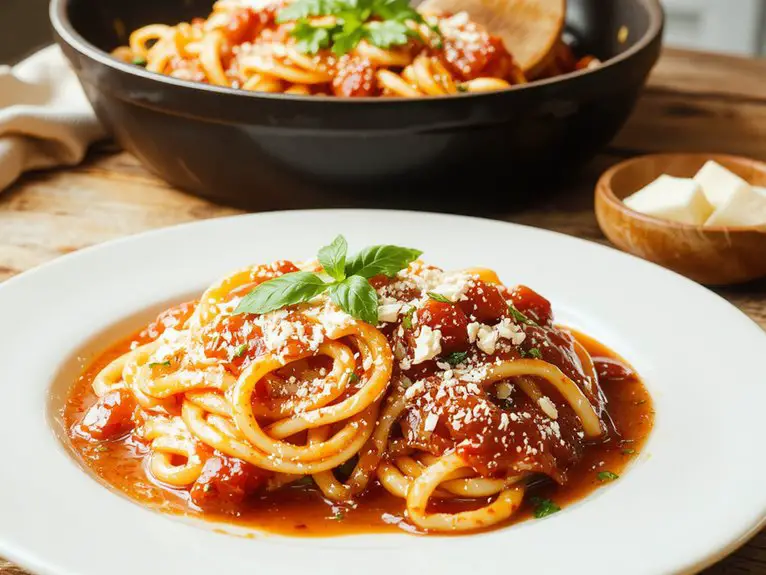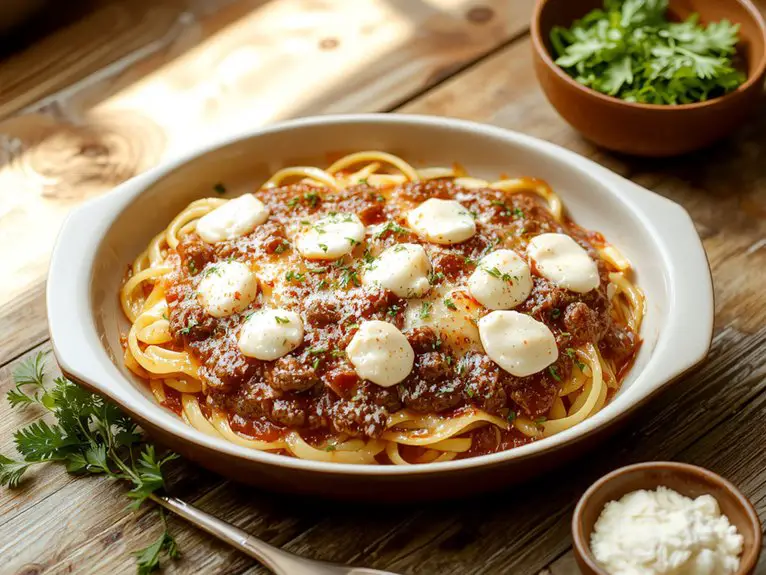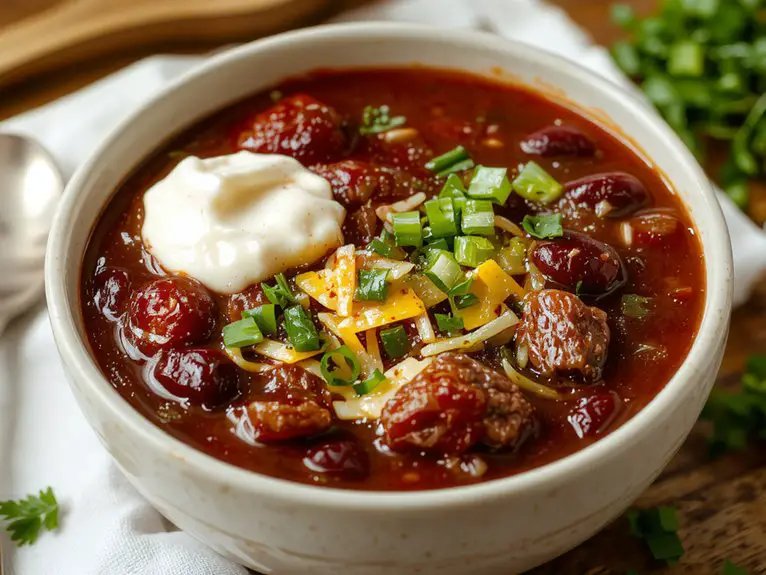Recipe
Let me just say this upfront: once you’ve tried this homemade Bolognese, there’s no going back to jarred sauce. This recipe is a game-changer—rich, hearty, and packed with layers of flavor that’ll make you feel like you’re dining in an Italian trattoria.
The secret? A splash of red wine and a slow simmer that lets the tomatoes, garlic, and aromatic herbs meld into something truly magical. Every spoonful is a burst of savory goodness, with tender ground beef and a velvety texture that clings perfectly to your favorite pasta.
Trust me, I’ve been perfecting this recipe for years, and it’s become a family favorite for a reason. Whether you’re cooking for a crowd or just treating yourself, this Bolognese is worth every minute. Let’s get started!
Ingredients
A great Bolognese starts with quality ingredients—each one builds layers of flavor that make this sauce unforgettable. Here’s what you’ll need, plus a few chef-approved swaps and secrets:
- Ground Beef (80/20 blend): The fat content is key for richness. No lean stuff here—embrace the juiciness. (Swap: Half beef, half pork for extra depth.)
- Pancetta or Bacon (diced): The salty, smoky base that kicks off the flavor. Don’t skip—this is your foundation.
- Onion, Carrot, Celery (finely chopped): The holy trinity of Italian cooking. Equal parts for balance. Pro tip: Pulse in a food processor to save time.
- Garlic (minced): Fresh only. Powder won’t cut it.
- Tomato Paste: Cook it until it’s brick-red and caramelized—this deepens the sauce’s sweetness.
- Crushed Tomatoes (San Marzano if possible): Bright, tangy, and less acidic. Canned is fine (and often better in winter).
- Whole Milk or Heavy Cream: Sounds odd, but it tames acidity and adds silkiness. Non-negotiable.
- Dry White Wine (or Red for bolder flavor): Deglazes the pan and adds complexity. No wine? Use broth + a splash of vinegar.
- Parmigiano-Reggiano (freshly grated): The salty, nutty finish. Pre-grated won’t melt the same.
- Fresh Herbs (bay leaf, thyme): Dried works, but fresh herbs tied in a bundle (remove before serving) elevate everything.
Little Win: Save pasta water to loosen the sauce—it’s starchy gold. And always finish with a knob of butter for gloss.
How to Make the Best Authentic Bolognese Sauce Techniques

– Adjust seasoning – Taste and add more salt, black pepper, or a pinch of sugar if needed.
Let it rest off heat for 10 minutes before serving—this helps flavors meld.
*Flexibility:* For a richer sauce, swap half the milk for heavy cream.
– Serve right – Toss with al dente pappardelle or tagliatelle, and top with grated Parmigiano-Reggiano.
*Pro tip:* Reserve some sauce for freezing—it tastes even better the next day!
Nutrition
This homemade Bolognese recipe is packed with wholesome ingredients, providing a balanced mix of nutrients. Here’s the nutritional breakdown per serving:
| Nutrient | Amount |
|---|---|
| Calories | 350 kcal |
| Protein | 18 g |
| Carbohydrates | 25 g |
| Fat | 18 g |
| Fiber | 4 g |
| Sugar | 6 g |
| Sodium | 450 mg |
Chef Tips
Making a great Bolognese isn’t just about the ingredients—it’s how you handle them. I always brown the meat in small batches to avoid steaming it, ensuring it’s nicely caramelized.
Slowly sauté the soffritto until it’s soft and sweet.
Simmer the sauce low and slow—at least 3 hours—to develop depth.
Finish with a splash of milk to balance acidity and enrich the texture. Patience is key.
Frequently Asked Questions
Can I Freeze Leftover Bolognese Sauce?
Yes, I can freeze leftover bolognese sauce. I let it cool first, then transfer it to airtight containers or freezer bags. It lasts up to three months, and I just reheat it when I’m ready.
What Wine Pairs Best With Bolognese?
I’d pair Bolognese with a medium-bodied red wine like Chianti or Sangiovese—they’ve got enough acidity to balance the richness. If you prefer something bolder, I’d go for a Cabernet Sauvignon or a Barbera. Cheers!
How Do I Reheat Bolognese Without Drying It Out?
I’d reheat my Bolognese slowly on low heat, stirring often to keep it moist. Adding a splash of water, broth, or tomato sauce helps prevent drying out. Using a covered pan traps steam, keeping it rich and flavorful.
Can I Make Bolognese in a Slow Cooker?
Yes, I can make bolognese in a slow cooker. I’ll brown the meat first, then add everything to the cooker on low for 6-8 hours, stirring occasionally. It’ll deepen the flavors without drying it out.
What’s the Difference Between Bolognese and Meat Sauce?
I’ve always thought the main difference is bolognese’s richer, deeper flavor from slow cooking with wine, milk, and veggies, while meat sauce is simpler—just ground meat and tomatoes. They’re like cousins, but bolognese feels fancier.

